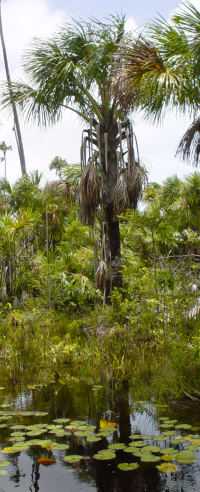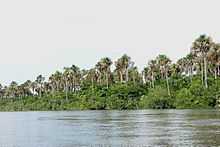Mauritia flexuosa
| moriche palm | |
|---|---|
 | |
| Palma canangucha | |
| Scientific classification | |
| Kingdom: | Plantae |
| (unranked): | Angiosperms |
| (unranked): | Monocots |
| (unranked): | Commelinids |
| Order: | Arecales |
| Family: | Arecaceae |
| Genus: | Mauritia |
| Species: | M. flexuosa |
| Binomial name | |
| Mauritia flexuosa L.f. | |
| Synonyms[1] | |
| |
Mauritia flexuosa, known as the moriche palm, ité palm, ita, buriti, canangucho (Colombia), or aguaje (Peru), is a palm tree. It grows in and near swamps and other wet areas in tropical South America. It has been reported from Trinidad, Colombia, Venezuela, Guyana, Suriname, French Guinea, Brazil, Ecuador, Peru and Bolivia.[2]
Mauritia flexuosa is an elegant tree which can reach up to 35 meters in height. The large leaves form a rounded crown. The flowers are yellowish, and appear from December to April. The fruit, which grows from December to June, is a chestnut colour and is covered with shiny scales. The yellow flesh covers a hard, oval, nut. The seeds float, and this is the means by which the palm tree propagates. In natural populations the tree reaches very high densities.[3]
Fruit
Moriche palm fruit is edible, has a high vitamin C content, and used to make juice, jam, ice cream, and a fermented "wine". An oil high in vitamin A is extracted from the pulp and is frequently used to treat burns because of its soothing qualities. The inflorescence buds are eaten as a vegetable, and the sap can be drunk fresh or fermented (see palm wine). Threads and cords are locally produced from the tree's fibers.
Buriti oil is an orange-reddish oil extracted from the fruit of the moriche palm. The oil contains high concentrations of oleic acid, tocopherols and carotenoids, especially betacarotene. Recently it has been found to filter and absorb cancer-causing UV rays from the sun.[4]
Oil
The oil has a reddish color is used as ink of hides and skins.[5]
In addition, the Buriti oil has an effective sunscreen which reduces skin dryness and also has properties that provide elasticity to the skin and fight aging.[6] It is a good agent that provides capillary hydration and protection against sunlight to hair damaged by it. Acts as a good product for dry and brittle hair.[7] The buriti oil is very rich in oleic acid (72.5%), a type of mono-unsaturated fatty acid that is abundant in olive oil and is associated with lowering the risk of coronary heart disease. Furthermore, it is considered to be the richest natural source in beta-carotene (30 milligrams/100 g pulp), exceeding 20 times what is found in carrots. Betacarotene is one of the most powerful antioxidants, known for its ability to renew cells, and serves as an excellent natural skin exfoliator. Due to its ability to absorb radiation in the range of visible and ultraviolet light, the oil is used by the cosmetic industry as a solar filter that reduces the dryness of the skin. In anti-aging formulas this oil increases the elasticity of the skin.[8]
| Composition of fatty acids | ||
|---|---|---|
| valeric acid | % Weight | 0.6–1.00 |
| palmitic acid | % Weight | 14.0–19.0 |
| stearic acid | % Weight | 1.5–6.0 |
| oleic acid | % Weight | 55.0–75.0 |
| linoleic acid | % Weight | 10.0–15.0 |
| linolenic acid | % Weight | 0.5–1.5 |
| saturated | % | 22 |
| unsaturated | % | 78 |
Ecology
This tree is important to many animal species; several bird species, such as the red-bellied macaw, sulphury flycatcher and moriche oriole, use it for nesting and food. Many ungulates, fish and monkeys depend on the fruit.[9]
Miscellaneous
The government of the Federal District - the Brazilian state where the country's capital, Brasília, is located - is called Palácio do Buriti ("Buriti Palace"). Across the street from the building there is a square with fountains and a single moriche palm tree, which was taken from the outskirts of the city and replanted there. The species is a common feature of the cerrado vegetation that predominates in central Brazil.
-
-

-
.jpg)
-
-
-
-
-
-

-

Fruits
-

Moriche Palm fruit, also called aguaje in Peru.
-

Karajá people, Cart lid "Warabahu"
References
- ↑ The Plant List Mauritia flexuosa
- ↑ Kew World Checklist of Selected Plant Families, Mauritia flexuosa
- ↑ http://horizon.documentation.ird.fr/exl-doc/pleins_textes/pleins_textes_6/b_fdi_43-44/010005452.pdf
- ↑ http://cat.inist.fr/?aModele=afficheN&cpsidt=18336612
- ↑ PESCE, Celestino. Oleaginosas da Amazonia.-Belém: Museu Paraense Emilio Goeldi, 2009. 334 p.: il. ISBN 978-85-61377-06-9 (MPEG) e 978-85-60548-39-2 (MDA)
- ↑ ÓLEO BURITI. Amazon Oil Industry. http://www.amazonoil.com.br/produtos/oleos/buriti.htm
- ↑ Os 8 Benefícios do Buriti Para Saúde. http://www.saudedica.com.br/os-8-beneficios-do-buriti-para-saude/
- ↑ Morais, Luiz Roberto Barbosa Química de oleaginosas : valorização da biodiversidade amazônica = Chemistry of vegetable oils : valorization of the amazon biodiversity. — Belém, PA : Ed. do Autor, 2012. — (Oleaginosas). CDD-633.850981
- ↑ http://assets.wwf.ch/downloads/aguaje_wwf_peru.pdf
External links
| Wikimedia Commons has media related to Mauritia flexuosa. |





